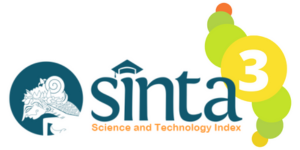INDUCTION OF DROUGHT RESISTANCE IN MELON (Cucumis melo L.) M15 WITH HORMOPRIMING BRASSINOSTEROID BASED ON MORFOLOGY, ANATOMY, AND PHYSIOLOGY ASPECTS
DOI:
https://doi.org/10.26877/bioma.v13i1.893Keywords:
Brassinosteroids, Cucumis melo L., Drought, Hormopriming, Plant Growth Regulator, Climate change, Morphology, Anatomy, PhysiologyAbstract
Melon productivity in Indonesia has been declining. Global climate change is affecting the productivity of melons. Long-term droughts have contributed to a reduction in plant growth and development. Hormopriming is an alternative to increase the germination and growth of melon plants by soaking seeds in a solution of plant growth regulators. Brassinosteroid can enhance germination and plant tolerance under drought conditions. The objective of this research is to examine the impact of brassinosteroid hormopriming treatment on the germination and growth of melon plants subjected to various degrees of drought stress. The study utilized a two-factor fully randomized design. The brassinosteroid concentrations used were 0, 0.05, 0.10, and 0.15 ppm. Media with different water capacities of 75%, 50%, and 25% Space Capacity (SC) were used to test drought stress resistance. Water capacities were examined using the gravimetric method. This study's findings suggest that treating melon plants with brassinosteroid variations can induce drought resistance in M15 melons. A brassinosteroid concentration of 0.15 ppm is the best concentration, as it can increase all parameters of plant growth and adaptation under each variation of water availability provided. The findings of this study can serve as a reference for melon cultivators constrained by dry land conditions to increase the efficiency of cultivation.
References
Abdulrrahman, A., Hamdani, H., & Yanti, NR. (2023). Analisis Usahatani Melon (Cu-cumis melo L.) di Kecamatan Martapura Kabupaten Banjar. Frontier Agribisnis, 7(1), 63-69. https://doi.org/10.20527/frontbiz.v7i1.8280
Ali, AS., & Elozeiri, AA. (2017). Metabolic Processes During Seedd Germination. In Lopez, JCJ (Eds), Advances in Seed Biology (pp. 141-166) London, England: Intech.
Anggarwulan, E., & Solichatun. (2007). Kajian klorofil dan Karotenoid Plantago major L. dan Phaseolus vulgaris L. sebagai Bioindikator Kualitas Udara, Biodiversitas, 8(4): 279-282. htpps://doi.org/10.13057/biodiv/d080407
Bates, IS., Waldren, RP., & Teare, ID. (1973). Rapid Determination of Free Proline for Water Stres Studies, Plant and Soil, 39(2): 205-207. https://doi.org/10.1007/BF00018060
Castorina, G., & Consonni, G. (2020). The Role of Brassinosteroid in Poaceae: A Ge-netic Perpective. International Journal of Molecular Science, 21(4), 1-16. https://doi.org/10.3390/ijms21041191
Daryono, BS., & Maryanto SD. (2016). Keanekaragaman dan Potensi Sumber Daya Genetik Melon. Yogyakarta: Gadjah Mada University Press.
Dwidjoseputro, D. (1992). Pengantar Fisiologi Tumbuhan. Jakarta, Gramedia Pustaka Utama.
Effendi, Y. (2008). Kajian Resistensi Beberapa Varietas Padi Gogo (Oryza sativa L.) terhadap Cekaman Kekeringan (Master’s thesis). Program Pascasar-jana, Program Studi Agronomi, Universitas Sebelas Maret Surakarta, Indo-nesi.
Gayathri, N., Gopalakrishnan, M., & Sekar, T. (2016). Phytochemical screening and antimicrobial activity of Capsicum chinense Jacq, International Journal Adv.Pharmaceutics, 5(1): 12-20. https://doi.org/10.7439/ijap
Gillani, SFA., Zhuang, Z., Rasheed, A., Haq, IU., Abbasi, A., Ahmed, S., Wang, Y., Khan, MT., Sardar, R., & Peng, Y. (2022). Brassinostroids Induced Drought Re-sistance of Contrasting Drought Responsive Genotypes of Maize at Physiologi-cal and Transcriptomic Levels. Frontiers in Plant Science, 13(22), 1-16. https://doi.org/10.3389/fpls.2022.961680
Hola, D. (2019). Role of Brassinosteroids in The Plant Response to Drought: Do We Know Anything for Certain?. in S. Hayat., M. Yusuf., R. Bhardwaj., &A. Bajguz (Eds.), Brassinosteroid: Plant Growth and Development (pp. 101-168). Singapore: Springer Science.
Huang, L., Zhang, L., Zeng, R., Wang, C., Zhang, H., Wang, L., Liu, S., Wang, X., Liu, S., Wang, X., & Chen, T. (2020). Brassinosteroid Priming Improves Peanut Drought Tolerance Via Eliminating on Genes in Photosynthesis and Hormone Signaling, Genes, 11(8): 1-23. https://doi.org/10.3390/genes11080919
Irjayanti, AD. Wibowo, AS., Stiyaningsih, H., Putri, IM., Gitaningtyas, OP., Areka, SK., Supraapti, W., & Nurfalah, Z. (2022). Statistik Hortikultura 2022. Jakarta: Badan Pusat Statistik Indonesia.
Khumaero, WW., Efendi, D., & Suwarno, WB. (2014). Evaluasi Karakteristik Hortikultura Empat Genotipe Melon (Cucumis melo L.) Pusat Kajian Hortikultura Tropika IPB, Jurnal Hortikultura Indonesia, 5(1):56-63. https://doi.org/10.29244/jhi.5.1.56-63
Kour, J., Kohli, SK., Khanna, K., Bakshi, P., Sharma, P., Sigh, AD., Ibrahim, M., Devi, K., Sharma, N., Ohri, P., Skalicky, M., Brestic, M., Bhardwaj, R., Landi, M., & Sharma, A. 2021. Brassinosteroid Signaling, Crosstalk and Physiological Func-tion in Plants Under Heavy Metal Stress, Frontiers in Plant Science, 12(21): 1-19. https://doi.org/10.3389/fpls.2021.608061
Lesilolo, MK., Patty, J., & Tetty, N. (2012). Penggunaan Desikan Abu dan Lama Sim-pan terhadap Kualitas Beni Jagung (Zea mays L.) pada Penyimpanan Ruang Terbuka. Agrologia, 1(1): 51-59. http://dx.doi.org/10.30598/a.v1i1.298
Lestari, EG. (2006). Hubungan Antara Kerapatan Stomata Dengan Ketahanan Kekeringan pada Somaklon Padi Gajahmungkur, Towuti, dan IR 64, Biodiversi-tas, 7(1): 44-48. https://doi.org/10.13057/biodiv/d070112
Lhout, FA., Zunzunegui, M., Barradas, MCD., Tiradi, R., Clavijo, A., & Novo, FG. (2001). Comparison of Proline Accumulation in Two Mediterranean Shrubs Subjected to Natural and Experimental Water Deficit, Plant and Soil, 230(2):175-183. https://doi.org/10.1023/A:1010387610098
Lutts, S. (2016). Seed Priming: New Comprehensive Approaches for an Old Empirical Technique. In S. Araujo (Eds.), New Challenges in Seed Biology, Basic and Translational Research Driving Seed Technology. (pp.1-46). New York, USA: In Tech Open.
Maryani., Prabawani, RL., & Daryono, BS. (2009). Struktur Anatomi Epidermis Daun Lima Kultivar Melon (Cucumis melo L.) Berdasarkan Resistensinya terhadap Jamur Tepung (Sphaerotheca fuliginea Poll), Biota, 14(2): 105-114. https://doi.org/10.24002/biota.v14i2.2688
Rusmana. (2017). Rasio Tajuk Akar Tanaman Melon (Cucumis melo L.) pada Media Tanam dan Ketersediaan Air Yang Berbeda, Jurnal Agroeko Teknologi, 9(2): 137-142. https://dx.doi.org/10.33512/j.agrtek.v9i2.5111
Shao, HB., Chu, LY., Jaleel, CA., & Zhao CX. (2008). Water Deficit Stress Induced Anatomical Changes in Higher Plants, Plant Biology and Pathology, 331(3):215-225. https://doi.org/10.1016/j.crvi.2008.01.002
Siddiqui, H., Hayat, S., & Bajguz, A. (2018). Regulation of Photoshyntesis by Brassinosteroid in Plants, Acta Physiologiae Plantarum, 40(59): 40-59. https://doi.org/10.1007/s11738-018-2639-2
Song, Z., Wang, L., Lee, M., & Yue, GH. (2023). The Evolution and Expression of Stomatal Regulators in C3 and C4 Crops: Implications on The Divergent Drought Tolerance, Plant Science, 1(14):1-10. https://doi.org/10.3389/fpls.2023.1100838
Sutopo, L. (2002). Teknologi Benih (edisi revisi). Jakarta: PT Raja Grafindo Persada.
Swibawa IG, Oktarino H. (2010). Pengaruh kadar air tanah terkontrol terhadap kelim-pahan nematoda parasit tumbuhan (Prosiding, Universitas Lampung). Retrieved from Seminar Nasional Sains & Teknologi III Universitas Lampung, Indonesian.
Tian, H., Lv, B., Ding, T., Bai, M., & Ding Z. (2018). Auxin-BR Interaction Regulates Plant Growth and Development, Frontiers in Plant Science, 8(2256):1-8. http://dx.doi.org/10.3389/fpls.2017.02256
Xiong, M., Chu, L., Li, Q., Yu, J., Yang, Y, Zhou, P., Zhou, Y., Zhang, C., Fan, X., Zhao, D., Yan, C., & Liu, Q. (2021). Brassinosteroid and Gibberellin Coordinate Rice Seed Germination and Embryo Growth by Regulating Glutelin Mobilization, The Crop Journal, 9(5):1039-1048. https://doi.org/10.1016/j.cj.2020.11.006
Zhang, H., Zao, D., Tang, Z., Zhang, Y., Zhang, K., Dong, J., &Wang, F. 2022. Exoge-nous Brassinosteroids Promotes Root Growth, Enhances Stress Tolerance, and Increases Yield in Maize, Plant Signaling and Behavior, 17(1): 1-14. https://doi.org/10.1080/15592324.2022.2095139
Zhang, S., Wei, Y., Lu, Y., & Wang, X. 2019. Mechanism of Brassinosteroid Interact-ing with Multiple Hormones, Plant Signaling, 4(12):1117-1120. https://doi.org/10.4161/psb.4.12.9903
Zhiponova, MK., Vanhoutte, I., Boudolf, V., Betti, C., Dhondt, S., Coppens, F., Mylle, E., Maes, S., Garcia, MPG., Delgado, AIC., Inze, D., Beemster, GTS., Veylder, LD., & Russinova, E. (2012). Brassinosteroid Production and Signaling Differ-entially Control Cell Division and Expansion in the Leaf, New Phytologist, 197(2):490-502. https://doi.org/10.1111/nph.12036
Zoulias, N., Hrrison, EL., Casson, SA., & Gray, JE. 2018. Molecular Control of Sto-matal Development, Biochemical Journal, 475(2):441-454. https://doi.org/10.1042%2FBCJ20170413








